The quick-step of the 1st Battalion, officially known as “The Royal Sussex”, is believed to be a French tune, and tradition has it that it was adopted by the 35th Foot at the time that the Roussillon plume was granted as a distinction after the Battle of Quebec. Whether there was any connection between the tune and the Royal Roussillon Regiment of the French Army is at present uncertain.

2nd Volunteer Battalion Band c1900

1st Battalion Band – Ambala, Punjab, India, 1905
The slow-march of the 1st Battalion, Roussillon, which at one time was invariably played by the band before the quick-step and the National Anthem, at the end of a programme, was inherited from the 35th, but nothing is known of its origin or history.
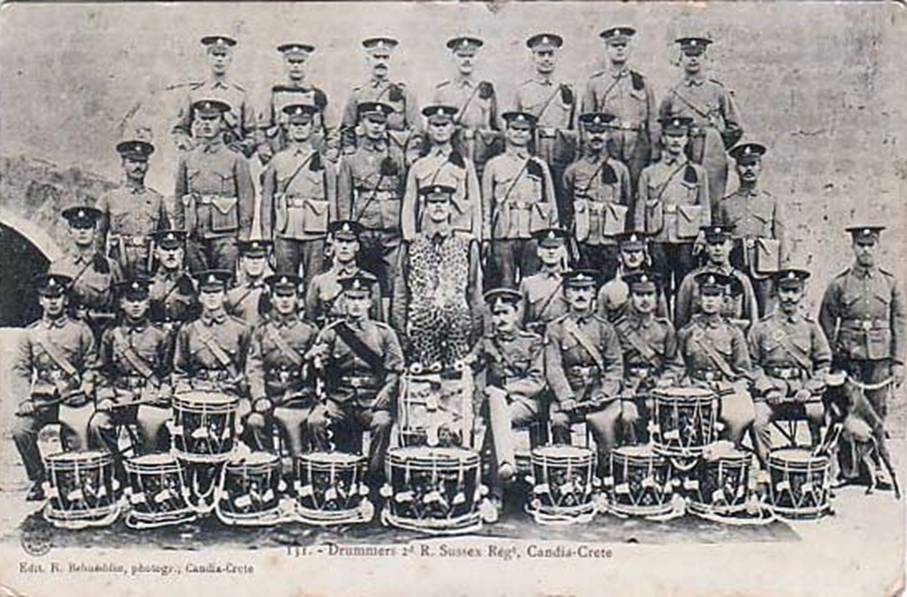
2nd Battalion Drummers – Candia, Crete 1906
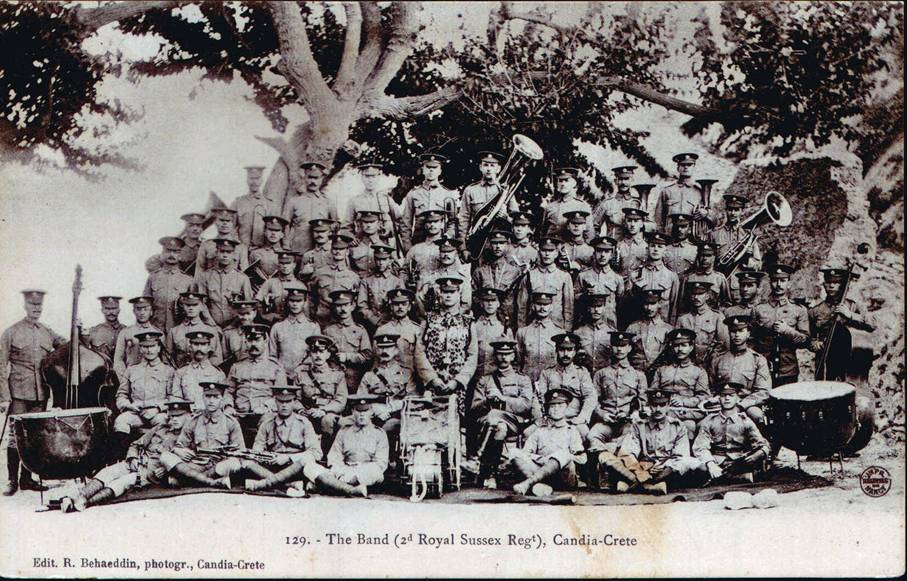
2nd Battalion Band – Candia, Crete 1906
The quick-step of the 2nd Battalion, “The Lass of Richmond Hill”, was received down from the 107th Foot. The Lass of Richmond Hill was a Miss Frances I’Anson, of Hill House, Richmond, York shire. The music was written by James Hook, and the words of the ballad by one Leonard McNally, who married the young lady. It cannot be found that there was any particular reason why this tune was adopted by the 107th Foot. Probably it was chosen by some Commanding Officer because it was a favourite tune of his. Such, it is believed, is the true explanation for the adoption of their regimental marches by many regiments. A case in point is the XIVth Hussars, whose quick-step is the same as that of our 1st Battalion. Enquiry has been made, and the XIVth can offer no explanation, historical or traditional, other than that “the tune was most likely chosen by some past Commanding Officer because he liked it.”
The above may be explained by the following extract from Captain G. D. Martineau’s “A History of The Royal Sussex Regiment”:
“A pleasant anecdote belongs to this phase of history (circa 1800): at Dover on one occasion, the band of the 14th King’s Hussars indulged so excessively in liquor that their place on parade, next day, was taken by the band of the 35th. As a reminder of that lapse, the Regimental March (later entitled “The Royal Sussex”) was ordered to be played on ceremonial parades in future, and was still being played by the l4th/20th King’s Hussars, when they trooped the Peninsula Guidons in 1950.”1
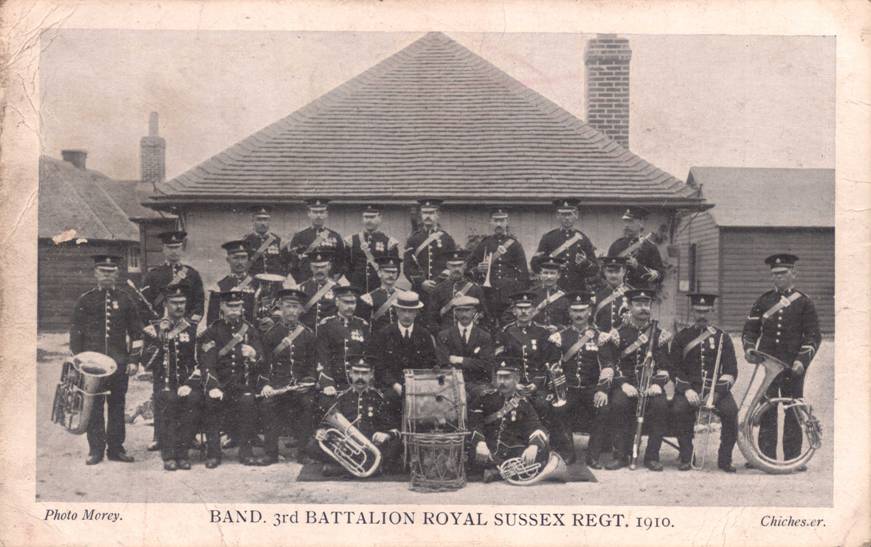
After the amalgamation of the 1st and 2nd Battalions, in 1948, the two marches were combined in a single score.2
Now we come to what, if it is permissible to coin a word, may be described justly as the “nick-song” or “nick-march” of the Royal Sussex Regiment – “Sussex by the Sea”, which has quite taken its place as a sort of subsidiary regimental march by all Battalions of the Regiment. The history of “Sussex by the Sea” is briefly as follows –
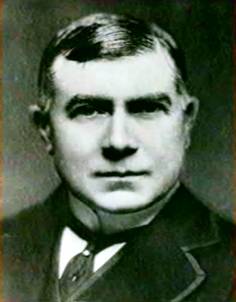
In about 1907, Mr. W. Ward-Higgs, who lived at the time in Sussex, and who took a great interest in the County and the County Regiment, was moved to try to produce a marching song in praise of Sussex. “Sussex by the Sea” was the result.3 As soon as it was published the author sent copies to an officer of the 2nd Battalion who was connected with him by marriage, and the song was sung, in about September, 1908, by that officer at concerts at Ballykinlar Camp, where the battalion was at that time. The tune at once became popular, and has remained so ever since.
Mr William Ward–Higgs lived at Hollywood House in South Bersted, Bognor Regis, at the time of writing “Sussex by the Sea” a fact commemorated today by a plaque on the side of the house. Ward-Higgs’s grave is in Bersted churchyard.

We have been advised by correspondent John Cowen that “Ward-Higgs was actually cremated in Norwood, south London, following his tragic suicide at Roehampton in 1936. The only extant memorials to him are the plaque on the front wall of Hollywood house, and another small plaque inside South Bersted church hall”.
Our thanks to the current owner of Hollywood House for allowing us to photograph the plaque for reproduction here.
The 5th (Cinque Ports) Battalion march was “Let the Hills Resound”, which was later adopted by the 4th/5th (Cinque Ports) Battalion4. The piece was written by Welsh Composer and Pianist Henry Brinley Richards 1819-1885.
“The Royal Sussex”, “The Lass of Richmond Hill”, and the post 1948 combined score are from the CD “The Princess of Wales’s Royal Regiment” by The Kohima Band of that Regiment, of which the Royal Sussex was a constituent part. Our thanks to the Kohima Band for permitting their use.
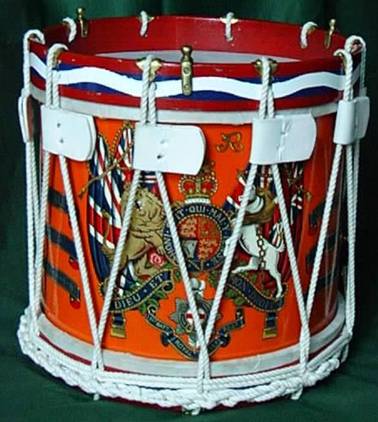
Victorian period drum of the 1st Battalion.
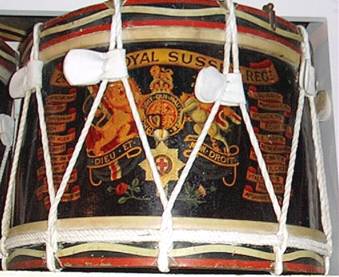
Post WWI Drum of the 2nd Battalion.
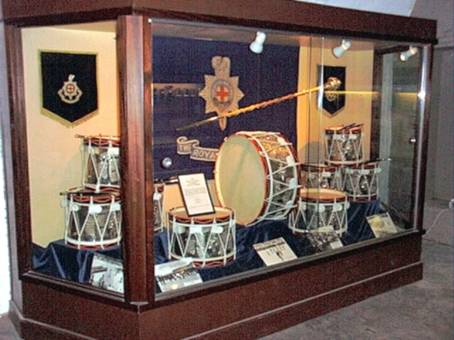
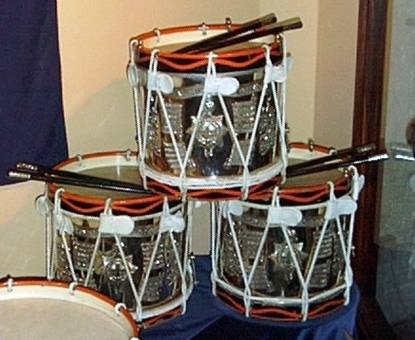
Silver drums presented to the Royal Sussex Regiment, Brighton 1962.
- A History of The Royal Sussex Regiment by Captain G.D. Martineau 1954 ⏎
- The Royal Sussex Regiment – The Last Twenty Years 1948-1967 by Major J. F. Ainsworth ⏎
- When his favourite sister-in-law had become engaged to Captain Waithman of the 2nd Battalion, he set about composing a song for them and produced ‘Sussex by the Sea’ – The Royal Sussex Regiment – The Last Twenty Years 1948-1967 by Major J. F. Ainsworth ⏎
- The Royal Sussex Regiment – The Last Twenty Years 1948-1967 by Major J. F. Ainsworth ⏎






